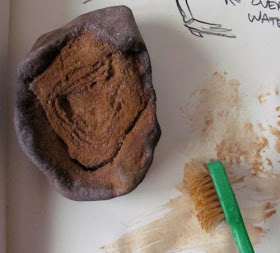
Also called "hematites," they’re chunks of iron ore conveniently encased in a saucer of rock. Sometimes the wave action has broken them open. If you wet the rusty iron oxide and scrub it with a toothbrush or a bristle paintbrush, you’ve got a very permanent dull orange pigment. Mix in a bit of gum arabic or acrylic medium or linseed oil, and you’ve got paint.
As far back as art’s cave-painting days, iron oxide has been a common and reliable pigment universally available to artists. That’s why brownish reds and oranges appear in all prehistoric art traditions. The best iron oxides were dug out of natural open pits in Siena, Italy, which gave its name (adding an extra “n”) to burnt sienna and raw sienna.
More on pigments (like what can you make from cysts on a whelk?) from Color and Light, page 90. Don’t forget that this coming Sunday is the deadline for the Book Trailer Video contest. Make your own quick video about the book and your art, get it seen by thousands, and if you get voted one of the finalists, you’ll win a signed and remarqued book.
Indian paint pots at auction

Very cool!
ReplyDeleteLove it!
ReplyDeleteI learned about the sienna term today. Pretty imformative, thanks.
ReplyDeleteMy best friend brought me the a gift of an assortment of rocks about 3 to 4 billion years old (that a "b" not an "m"). They were from Western Australia where here brother ran a mine.
ReplyDeleteThey were in shades of yellow through deep red and they all powdered easily. These are among the oldest rocks in the world and there I was using them as crayons! The best souvenir ever. I never asked if they were iron based or not.
very few- if any- paint makers use real seinna for burnt and other seinna, a company called east coast colors (brookyn) makes a beautiful real italian raw seinna.
ReplyDelete